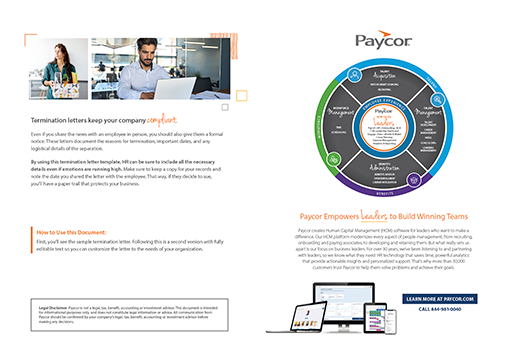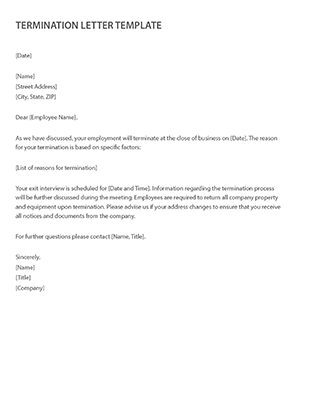Communicate Termination Details
Breaking up is hard to do – even at work. When it’s time to let an employee go, you’ll probably need to share the news in person. It’s just as important – if not more so – to give them written confirmation. Termination letters provide a written record of what happened, helping you avoid future confusion or legal issues.
During your initial meeting, the employee’s emotions might be running high. Giving them a written letter, or sending it after the meeting, will help them remember important details. But it can be hard to strike the right tone. HR should avoid going into unnecessary detail, or worse, skipping over uncomfortable truths. In the long term, explaining your reasons in a clear, compassionate manner will help the employee grow.
Why Termination Letters Matter
Termination letters have several purposes. First, you’re telling the employee why they’re being let go. Second, you’re confirming the timing and procedure of their departure. And perhaps most importantly, you’re keeping your company compliant.
These official documents serve as proof that you followed the correct termination procedures. By clearly listing your reasons, you demonstrate non-discrimination. Make sure you keep a copy of the letter for your records in case they attempt to dispute it in the future.
Writing a termination letter is just one step in the separation process. For more details on how to stay compliant, you can refer to our Terminating Employee Checklist.
What to Include in a Termination of Employment Letter
Let’s go through the key elements of a termination letter:
- Date of Termination
It may seem obvious, but forgetting the date can be a major issue. State the exact date and time that the person’s employment will come to an end. - Reason for Termination
This is the most important section of the letter. Here, you’ll describe the reason for the employee’s termination. Use clear, simple language, and stick to the facts. If it’s just a matter of poor performance, you can mention their failure to meet the standards of their performance improvement plan. Avoid generalizations and flowery or emotional language. Instead, list specific examples of poor conduct or performance. Speak for the company – not yourself. - Exit Interview
Schedule their exit interview for the end of the employee’s last day. These interviews are valuable opportunities for HR. You can ask how the employee feels about their time at the company, including what went well and what could be improved. The goal is for you to gather actionable information from candid feedback. Then, you can use that insight to update your company policy and boost retention rates. For more tips on conducting an exit interview, refer to our downloadable Exit Interview Template. - Next Steps
The employee may be in possession of company property, like a computer, phone, or badge. Let them know how to return it, the relevant deadlines, and any consequences if they fail to turn it in. Depending on their role, there might be other required steps in the separation process, like sharing passwords to company accounts. Make sure they understand what you expect of them. You can also tell them when to expect their last paycheck, in compliance with the final paycheck laws in your state. - Contact Details
Expect the departing employee to have questions after they receive the termination letter. Let them know who to contact for more information, and how best to get in touch. In most cases, you should direct them to someone on the HR team, instead of their former supervisor.
Sample Termination Letter
Writing a termination letter can be hard – but you can’t afford to make mistakes. Use Paycor’s customizable Termination Letter Template to ensure you’re including all the important details.











